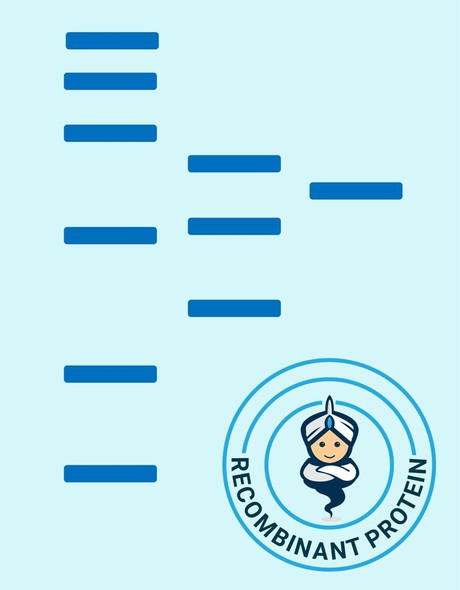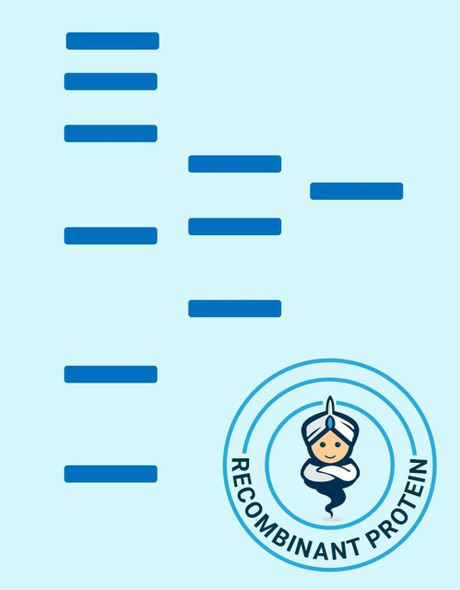Description
| Product Name: | Human GREM1 Recombinant Protein |
| Product Code: | RPPB3642 |
| Size: | 20µg |
| Species: | Human |
| Target: | GREM1 |
| Synonyms: | Gremlin-1 isoform 1, CKTSF1B1, DAND2, DRM, GREMLIN, IHG-2, PIG2, GREM1, Cell proliferation-inducing gene 2 protein, Cysteine knot superfamily 1, BMP antagonist 1, DAN domain family member 2, Down-regulated in Mos-transformed cells protein, Increased in high glucose protein 2. |
| Source: | Escherichia Coli |
| Physical Appearance: | Sterile Filtered colorless solution. |
| Formulation: | The GREM1 solution (0.5mg/ml) contains 20mM Tris-HCl buffer (pH 8.0), 0.4M Urea and 10% glycerol. |
| Stability: | Store at 4°C if entire vial will be used within 2-4 weeks. Store, frozen at -20°C for longer periods of time. For long term storage it is recommended to add a carrier protein (0.1% HSA or BSA).Avoid multiple freeze-thaw cycles. |
| Purity: | Greater than 90.0% as determined by SDS-PAGE. |
| Amino Acid Sequence: | MGSSHHHHHH SSGLVPRGSH MGSKKKGSQG AIPPPDKAQH NDSEQTQSPQ QPGSRNRGRG QGRGTAMPGE EVLESSQEAL HVTERKYLKR DWCKTQPLKQ TIHEEGCNSR TIINRFCYGQ CNSFYIPRHI RKEEGSFQSC SFCKPKKFTT MMVTLNCPEL QPPTKKKRVT RVKQCRCISI DLD |
GREM1 belongs to the BMP (bone morphogenic protein) antagonist family. Like BMPs, BMP antagonists comprise cystine knots and usually form homo- and heterodimers. The CAN (cerberus and dan) subfamily of BMP antagonists, to which GREM1 belongs, is characterized by a C-terminal cystine knot with an eight-membered ring. The antagonistic effect of the secreted glycosylated protein is because of its direct binding to BMP proteins. As an antagonist of BMP, GREM1 takes a place in regulating organogenesis, body patterning, and tissue differentiation. In mouse, GREM1 has been shown to convey the sonic hedgehog (SHH) signal from the polarizing region to the apical ectodermal ridge during limb bud outgrowth. Alternatively merged transcript variants encoding different isoforms have been found for this gene.
GREM1 Human Recombinant produced in E.coli is a single, non-glycosylated polypeptide chain containing 183 amino acids (25-184) and having a molecular mass of 20.7 kDa. GREM1 is fused to a 23 amino acid His-tag at N-terminus & purified by proprietary chromatographic techniques.
| UniProt Protein Function: | GREM1: Cytokine that may play an important role during carcinogenesis and metanephric kidney organogenesis, as a BMP antagonist required for early limb outgrowth and patterning in maintaining the FGF4-SHH feedback loop. Down-regulates the BMP4 signaling in a dose-dependent manner. Acts as inhibitor of monocyte chemotaxis. Interacts with SLIT1 and SLIT2 in a glycosylation- dependent manner. By high glucose through TGFB1-mediated pathways in mesangial cell. Down-regulated in tumor cell lines. Highly expressed in small intestine, fetal brain and colon. Weakly expressed in brain, ovary, prostate, pancreas and skeletal muscle. In brain found in the region localized around the internal capsule in the large subcortical nuclei, including caudate, putamen, substantia nigra, thalamus and subthalamus. Predominantly expressed in normal cells including neurons, astrocytes and fibroblasts. Belongs to the DAN family. 2 isoforms of the human protein are produced by alternative splicing. |
| UniProt Protein Details: | Protein type:Secreted, signal peptide; Secreted Chromosomal Location of Human Ortholog: 15q13.3 Molecular Function:morphogen activity; protein binding; receptor agonist activity; transmembrane receptor protein tyrosine kinase activator activity; vascular endothelial growth factor receptor 2 binding Biological Process: cell migration during sprouting angiogenesis; cell morphogenesis; collagen fibril organization; determination of dorsal identity; limb development; negative regulation of apoptosis; negative regulation of BMP signaling pathway; negative regulation of bone mineralization; negative regulation of bone remodeling; negative regulation of chondrocyte differentiation; negative regulation of osteoblast proliferation; positive regulation of cell proliferation; positive regulation of receptor internalization; positive regulation of telomerase activity; positive regulation of transcription from RNA polymerase II promoter; regulation of stress-activated MAPK cascade; signal transduction |
| NCBI Summary: | This gene encodes a member of the BMP (bone morphogenic protein) antagonist family. Like BMPs, BMP antagonists contain cystine knots and typically form homo- and heterodimers. The CAN (cerberus and dan) subfamily of BMP antagonists, to which this gene belongs, is characterized by a C-terminal cystine knot with an eight-membered ring. The antagonistic effect of the secreted glycosylated protein encoded by this gene is likely due to its direct binding to BMP proteins. As an antagonist of BMP, this gene may play a role in regulating organogenesis, body patterning, and tissue differentiation. In mouse, this protein has been shown to relay the sonic hedgehog (SHH) signal from the polarizing region to the apical ectodermal ridge during limb bud outgrowth. Alternatively spliced transcript variants encoding different isoforms have been found for this gene. [provided by RefSeq, Jul 2010] |
| UniProt Code: | O60565 |
| NCBI GenInfo Identifier: | 62510668 |
| NCBI Gene ID: | 26585 |
| NCBI Accession: | O60565.1 |
| UniProt Secondary Accession: | O60565,Q52LV3, Q8N914, Q8N936, |
| UniProt Related Accession: | O60565 |
| Molecular Weight: | |
| NCBI Full Name: | Gremlin-1 |
| NCBI Synonym Full Names: | gremlin 1, DAN family BMP antagonist |
| NCBI Official Symbol: | GREM1�� |
| NCBI Official Synonym Symbols: | DRM; HMPS; MPSH; PIG2; CRAC1; CRCS4; DAND2; HMPS1; IHG-2; DUP15q; C15DUPq; GREMLIN; CKTSF1B1�� |
| NCBI Protein Information: | gremlin-1 |
| UniProt Protein Name: | Gremlin-1 |
| UniProt Synonym Protein Names: | Cell proliferation-inducing gene 2 protein; Cysteine knot superfamily 1, BMP antagonist 1; DAN domain family member 2; Down-regulated in Mos-transformed cells protein; Increased in high glucose protein 2; IHG-2 |
| Protein Family: | Gremlin |
| UniProt Gene Name: | GREM1�� |
| UniProt Entry Name: | GREM1_HUMAN |






